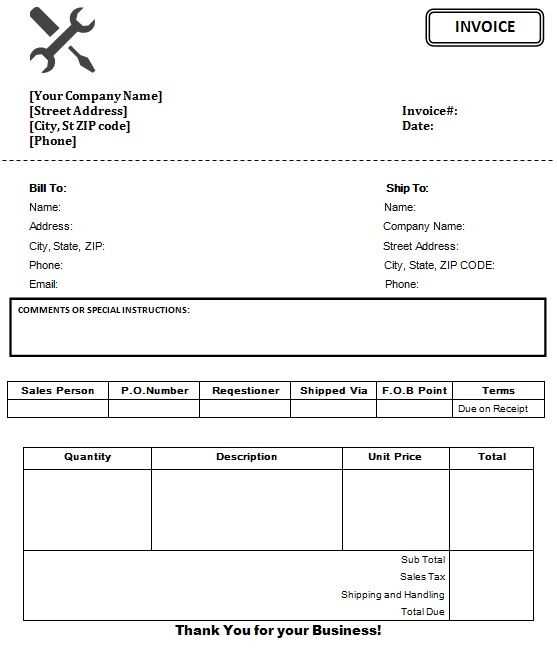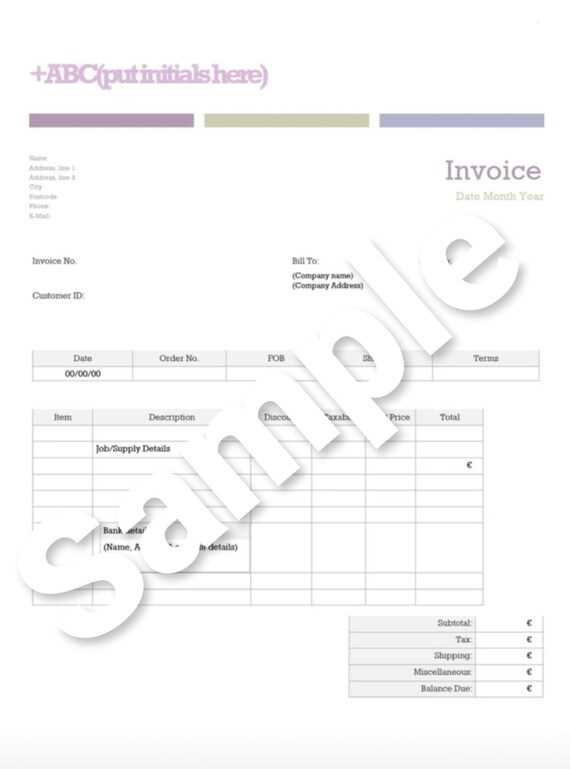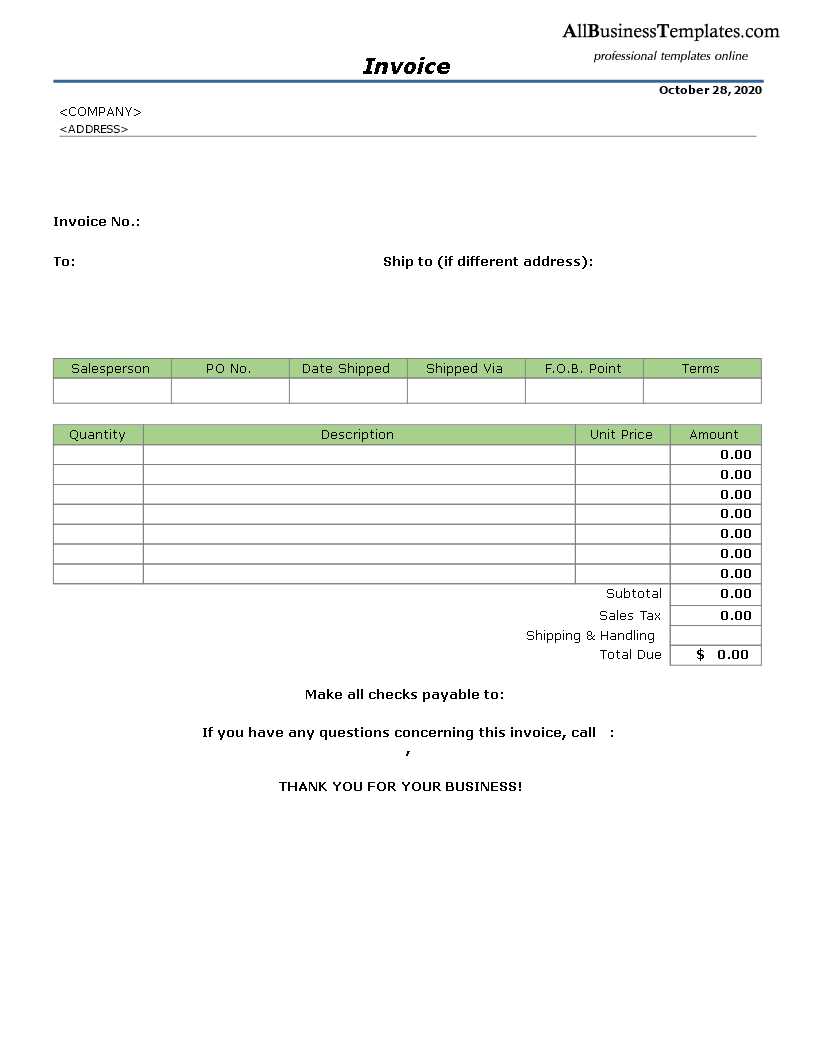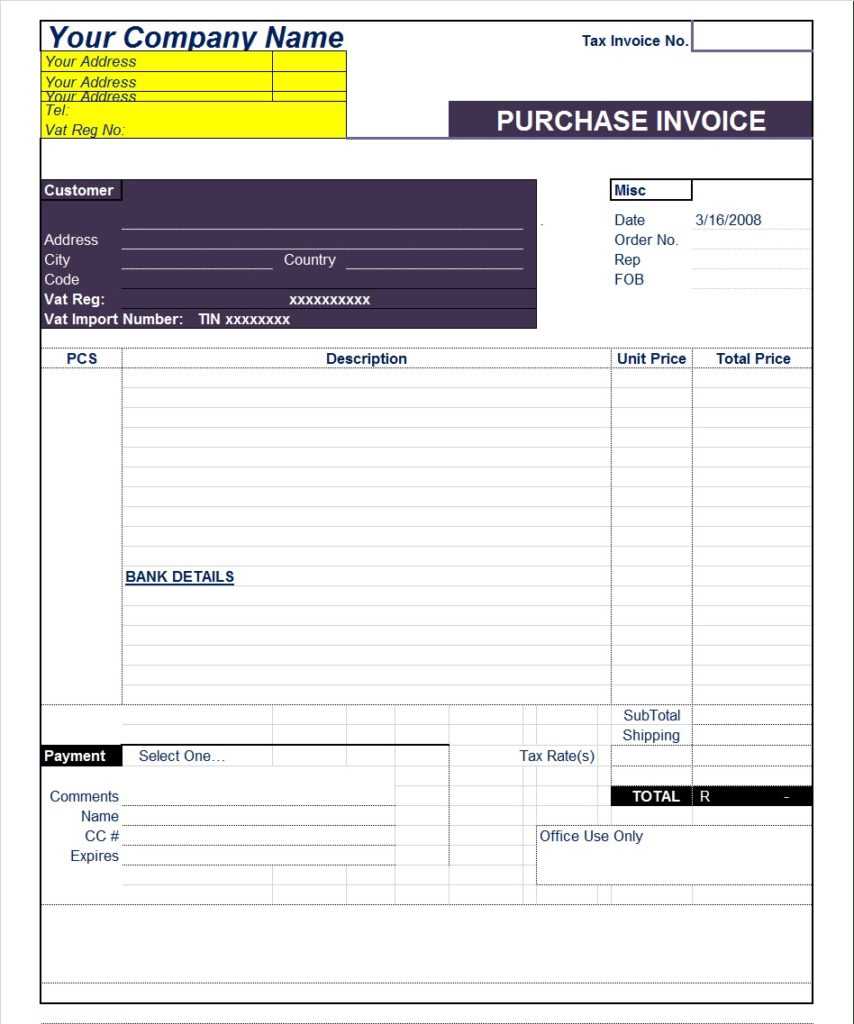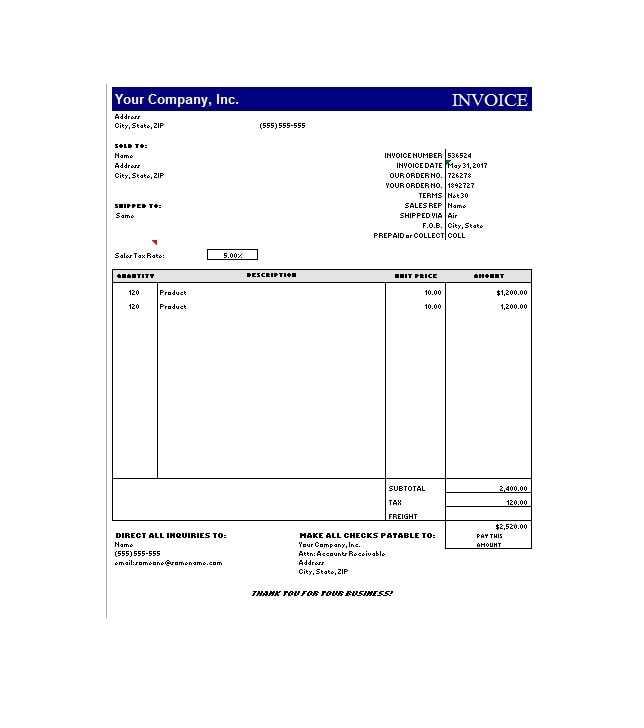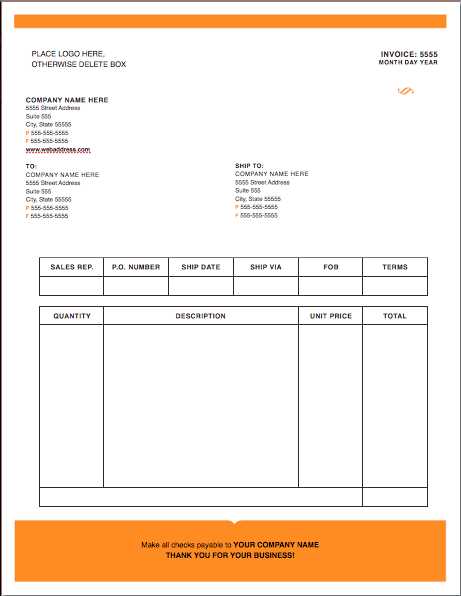Downloadable Fob Invoice Template for Simplified International Transactions
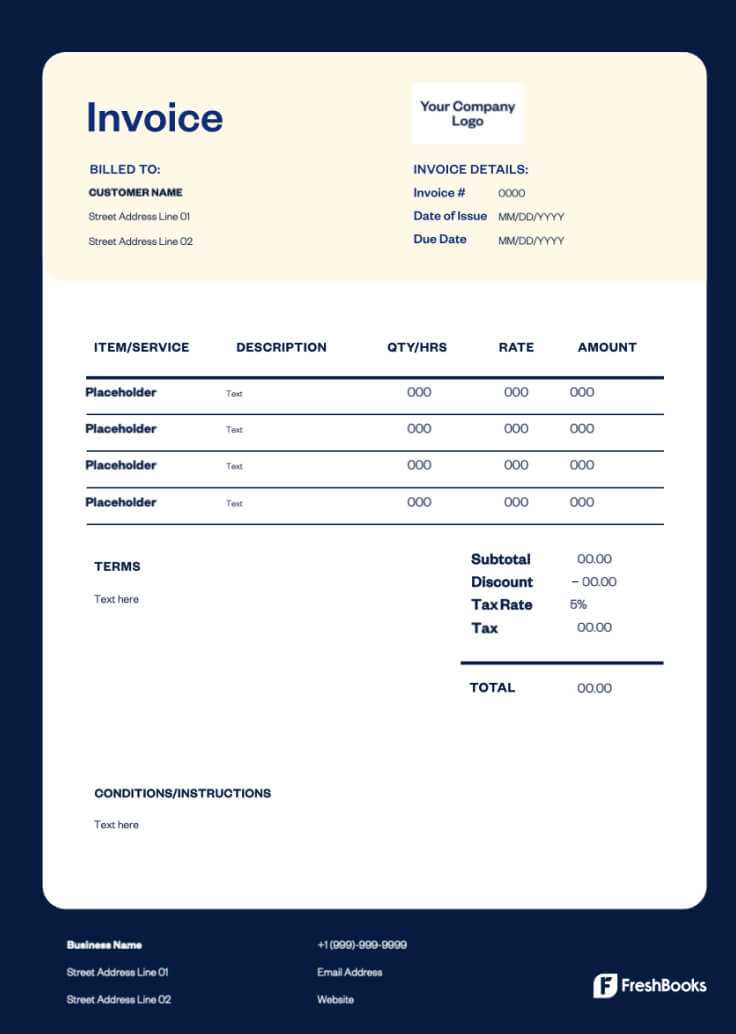
In global commerce, accurate and clear shipping documents are essential to ensure smooth transactions between buyers and sellers. These documents outline the terms of delivery, payment responsibilities, and conditions under which goods are transferred. Properly structured paperwork not only helps avoid misunderstandings but also ensures compliance with international trade regulations.
One of the most commonly used documents in international shipping is designed to specify the point at which responsibility for goods transfers from seller to buyer. It plays a critical role in managing risk, cost allocation, and shipment details. Whether you’re managing shipments for a small business or handling large-scale imports and exports, understanding how to create and use this kind of document is vital.
Creating a professional and effective shipping record requires attention to detail. It should include key information such as product descriptions, payment terms, shipping dates, and specific delivery instructions. By using a standardized approach, companies can streamline their processes and reduce the chances of errors or disputes.
Understanding Shipping Document Basics
In international trade, clear and precise documentation is crucial for defining the responsibilities and obligations between the buyer and seller. A well-structured document ensures smooth transactions and prevents any confusion regarding costs, delivery conditions, and risk management. These documents serve as a record of agreement between both parties, establishing the terms of how goods will be transferred and at what point liability shifts from one party to another.
The main purpose of such documentation is to specify the exact terms under which goods are delivered. This includes critical information such as:
- Delivery terms: Defining the responsibilities for shipping, insurance, and handling costs.
- Transfer of risk: Outlining when and where the risk of loss or damage to goods passes from the seller to the buyer.
- Payment conditions: Specifying when and how payment is made for the goods in question.
- Shipment details: Including product descriptions, quantities, and packaging information.
While the content of such a document can vary, there are essential components that must always be included to avoid disputes. Both parties must clearly understand when the goods are transferred and what each is responsible for during the shipping process. Understanding the core elements of this document helps businesses ensure they are adhering to agreed-upon conditions and legal requirements.
In this section, we will delve deeper into how to create this shipping record correctly, ensuring all necessary fields are covered to protect both the buyer and the seller. By following a standardized format, businesses can streamline their operations and minimize risks associated with global transactions.
Why Use a Shipping Document for International Transactions
In international shipping, it’s essential to clearly define the roles and responsibilities of both the buyer and the seller. By using a well-established document that outlines key terms, both parties can prevent misunderstandings and ensure a smooth exchange. This documentation serves as a safeguard, making sure that each party is aware of their obligations regarding shipping, costs, and risk transfer.
There are several important reasons why businesses choose this type of shipping record for their transactions:
- Clear risk management: This document clearly specifies when and where the responsibility for the goods transfers from the seller to the buyer, helping both parties manage potential risks of loss or damage.
- Cost allocation: By detailing which costs are the responsibility of the seller and which fall to the buyer, it helps avoid disputes over shipping, insurance, and handling fees.
- Legal protection: This formal record provides legal protection in case of a dispute. It acts as a reference point for both parties in resolving any issues that may arise during the shipping process.
- Efficiency in operations: Using a standardized document makes the shipping process more efficient by reducing administrative errors and streamlining communication between the buyer, seller, and logistics providers.
- Regulatory compliance: For businesses operating across borders, this type of documentation helps ensure compliance with international shipping regulations and customs requirements.
Overall, using this specific document helps businesses reduce uncertainty, avoid disputes, and keep their global operations running smoothly. It provides clarity for both the seller and the buyer, ensuring that everyone is aligned on the terms of the transaction from the start.
Key Components of a Shipping Document
When preparing a shipping document for international transactions, it’s crucial to include all necessary details to avoid any confusion or legal issues. This document serves as the formal record of the agreement between the buyer and the seller, and its contents define the terms of delivery, cost distribution, and risk management. Properly filling out this document ensures that both parties are on the same page regarding their responsibilities.
Here are the essential components that should be included in any well-structured shipping document:
- Product Description: A clear and detailed description of the goods being shipped, including quantities, dimensions, weight, and any identifying numbers (e.g., serial or part numbers).
- Shipping Terms: A section outlining the agreed-upon terms for shipping, such as delivery method (air, sea, land), delivery point, and the exact moment responsibility for the goods transfers from the seller to the buyer.
- Cost Breakdown: A detailed account of the costs involved, such as transportation, insurance, handling, customs duties, and any other relevant fees. This helps to avoid disputes over payment responsibilities.
- Payment Terms: Clear stipulations on when and how payment will be made, including any advance payments, credit terms, or conditions for final settlement.
- Delivery Information: Detailed instructions about the destination, including the address, contact details, and any special requirements for the delivery process.
- Dates and Deadlines: Important dates such as the date of shipment, expected delivery date, and any other relevant milestones in the transaction timeline.
- Seller and Buyer Information: Full contact details for both the seller and the buyer, including business names, addresses, phone numbers, and email addresses.
- Signature and Confirmation: A space for both parties to sign and date the document, confirming that they agree to the terms outlined and the transaction can proceed as planned.
Including all these components ensures that the shipping process is transparent and that both parties understand their roles. It also helps protect against misunderstandings or disputes, making the transaction smoother and more secure for everyone involved.
How to Create an Effective Shipping Document
Creating an effective shipping document is essential for ensuring smooth and transparent transactions between buyers and sellers in international trade. This document acts as a formal record of the agreement and outlines the terms of delivery, cost allocation, and the transfer of responsibility for the goods. By following a clear and organized approach, you can ensure that all critical information is included, preventing disputes or misunderstandings.
To create a reliable and accurate shipping document, follow these key steps:
- Use a Standardized Format: Start with a well-organized layout that includes all the necessary sections, such as product description, payment terms, shipping terms, and dates. Consistency is key to ensuring clarity and reducing the chance of errors.
- Clearly Define the Terms: Clearly state the responsibilities of both parties, including who is responsible for shipping costs, insurance, and customs duties. Specify the point at which risk for the goods transfers from the seller to the buyer.
- Include Detailed Product Information: Provide a complete description of the products being shipped, including quantities, dimensions, weight, and any identifying numbers (e.g., serial or part numbers). This ensures that both parties are clear on what is being exchanged.
- Be Specific About Delivery Details: Specify the delivery method (e.g., air, sea, land), the destination address, and any special requirements. Include any deadlines for shipment or delivery to ensure timely fulfillment of the contract.
- Break Down the Costs: Include a clear breakdown of all associated costs, such as transportation, insurance, handling, and customs duties. This ensures that there is no confusion about which costs the buyer and seller are each responsible for.
- Review Legal Requirements: Ensure that your document complies with local and international trade regulations. This may include customs documentation, tax information, or other legal requirements specific to the transaction or country of origin.
- Proof of Agreement: Include spaces for signatures from both parties, confirming that the terms have been agreed upon. This adds a layer of legal protection and accountability for both sides.
By following these steps, you can create a shipping document that is both clear and comprehensive, ensuring that all key details are captured and reducing the risk of errors or disputes. Whether you’re new to international trade or an experienced professional, this approach will help you streamline your
FOB vs CIF Documents: Key Differences
When it comes to international shipping, two common methods are often used to define the responsibilities between buyers and sellers: one where the seller assumes some costs and risks until the goods are handed over, and the other where the seller takes on more responsibility for the goods during transit. These two approaches–often represented as FOB and CIF–are widely used, but they differ in terms of who bears what costs and risks along the shipping journey.
Key Differences Between FOB and CIF
While both methods outline the terms of delivery, they differ significantly in their approach to shipping costs, insurance, and risk transfer. Below is a comparison of the two:
| Aspect | FOB (Free On Board) | CIF (Cost, Insurance, and Freight) | |||||||||||||||||||||||||||||||||||||||||
|---|---|---|---|---|---|---|---|---|---|---|---|---|---|---|---|---|---|---|---|---|---|---|---|---|---|---|---|---|---|---|---|---|---|---|---|---|---|---|---|---|---|---|---|
| Risk Transfer | The risk transfers from the seller to the buyer once the goods are loaded onto the shipping vessel. | The seller assumes the risk until the goods reach the destination port, even though ownership transfers at shipment. | |||||||||||||||||||||||||||||||||||||||||
| Cost Allocation | The buyer covers all shipping costs, insurance, and any additional fees once the goods are on board. | The seller pays for shipping, insurance, and freight until the goods reach the destination port. | |||||||||||||||||||||||||||||||||||||||||
| Insurance | The buyer is responsible for arranging and payi
Common Mistakes in Shipping DocumentsIn international trade, it’s essential to ensure that all shipping documentation is accurate and complete. Errors in these documents can lead to confusion, delays, and costly disputes. While it may seem straightforward, even minor mistakes can have significant consequences. Below, we highlight some of the most common mistakes that businesses make when preparing shipping records, and how to avoid them. Typical Errors in Shipping RecordsHere are some common mistakes that can occur when preparing shipping documentation:
How to Minimize ErrorsTo avoid these common mistakes, it’s important to use a structured approach and ensur How to Fill Out a Shipping DocumentFilling out a shipping document accurately is crucial for ensuring smooth transactions and avoiding potential disputes in international trade. This document serves as the official record between the buyer and the seller, outlining responsibilities such as shipping costs, risk transfer, and delivery terms. A properly completed document can prevent confusion and help streamline the logistics process. Step-by-Step Guide to Completing the Shipping RecordFollow these steps to ensure your shipping document is filled out correctly:
Tips for AccuracyTo minimize errors when completing the shipping document, take the time to double-check all information. Make sure all fields are filled in completely, including dates, quantities, and cost allocations. It’s also helpful to use a standardized format to ensure consistency and clarity. If necessary, consult with a legal or logistics expert to confirm that the terms meet international regulations. Best Practices for Shipping Document Accuracy
Ensuring the accuracy of shipping documentation is vital for smooth and efficient transactions in international trade. Any inaccuracies can lead to misunderstandings, delays, or even financial penalties. By following certain best practices, businesses can minimize the risk of errors and ensure that the terms of shipment, responsibility, and payment are clearly defined. Here are some essential best practices to follow when preparing shipping documents:
By adhering to these best practices, businesses can significantly reduce the chances of errors in shipping records and improve the efficiency of their international transactions. Accuracy in these documents not only ensures smoother operations but also helps protect your company from Shipping Document Formats Explained
In international transactions, the format of the shipping document is crucial for clear communication and smooth processing. Different formats are available, depending on the specific needs of the seller, buyer, and the mode of transportation. Understanding the various formats and their components can help ensure that all necessary information is included and that both parties are aligned on the terms of the shipment. Below is an overview of the most common shipping document formats and their components:
|
